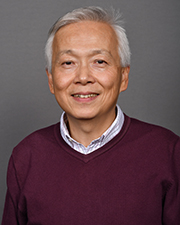
Xiaodong Cheng, PhD
- Professor, IMM-Texas Therapeutics Institute
Biography
Our laboratory studies intracellular signaling associated with second messenger cAMP. We apply multidisciplinary approaches, coupling biochemistry, biophysics and cell biology with pharmacology and chemical biology, to understand the structure and function of exchange proteins directly activated by cAMP (EPAC). Our goals are to unravel the signaling intricacies of EPAC proteins and to design pathway specific probes for these important signaling molecules so that their functions can be pharmaceutically exploited and modulated for the treatment of human diseases.
Our laboratory has developed first-in-class EPAC selective inhibitors and EPAC knockout mouse models to study the physiological functions and diseases relevance of this family of important signaling molecules. Recently, we have identified a potential use of EPAC inhibitors in the prevention and treatment of fatal rickettsioses. Currently, we are actively engaged in developing second generation isoform specific EPAC inhibitors and agonists and in exploring their potential uses in various human diseases including cancer, diabetes, chronic pain and infections.
RESEARCH PROJECTS:
- Structural and functional analyses of the exchange proteins directly activated by cAMP (EPAC), funded by NIH.
- Development of in vivo chemical probes targeting EPAC for suppressing pancreatic cancer metastasis, funded by NIH.
- Preclinical development of novel drug candidates targeting EPAC for the treatment of microbial infections caused by tick-borne bacteria Rickettsia, funded by NIH.
- Development of next generation of isoform specific EPAC modulators, in collaboration with NIH Chemical Genomics Center (NCGC).
- Examine the roles of EPAC proteins in major human diseases, such as cancer, chronic pain, diabetes and obesity, using EPAC knockout mouse models.
Publications
- Almahariq, M., Mei, F., and Cheng, X. cAMP Sensor EPAC Proteins and Energy Homeostasis. Trends in Endocrinology and Metabolism. 25:60-71, 2014.
- Gong, B.*, Shelite, T., Mei, F., Ha, T., Xu, G., Chang, Q., Hu, Y., Wakamiya, M., Ksiazek, T. G., Boor, P, J., Bouyer, R., Popov, V., Chen, J., Walker, D. H., and Cheng, X.* Exchange protein directly activated by cAMP plays critical role in fatal rickettsioses. Proc. Acad. Natl. Sci. USA. 110:19615-19620, 2013
- Breakthrough could lead to protection fro fatal infections.
- New Drug May help to treat rickettsial infections
- Research Reveals that deletion of Epac1 gene protects from fatal rickettsiosis
- Almahariq, M., Tsalkova, T., Mei, F. C., Chen, H., Zhou, J., Sastry, S. K., Schwede, F., and Cheng, X. A novel EPAC-specific inhibitor suppresses pancreatic cancer cell migration and invasion. Molecular Pharmacology. 83:122-128, 2013.
- Yan, J., Mei, F. C., Cheng, H. Q., Lao, D. H., Hu, Y., Wei, J., Patrikeev, I., Hao, D., Stutz, S. J., Dineley, K. T., Motamedi, M., Hommel, J. D., Cunningham, K. A., Chen, J.*, and Cheng, X*. Enhanced leptin sensitivity, reduced adiposity and improved glucose homeostasis in mice lacking of exchange protein directly activated by cAMP isoform 1. Molecular Cellular Biology. 33:918-926, 2013.
- Researchers identify and block protein that interferes with appetite-suppressing hormone
- Tsalkova, T., Mei, F. C., Li, Sheng, Chepurny, O. G., Liu, T., Woods, Jr., V. L., Holz, G.G., and Cheng, X. Isoform-specific antagonists of exchange protein directly activated by cAMP. Proc. Acad. Natl. Sci. USA.109:18613-18618, 2012.